
Food waste in America occurs mostly at the consumer level. “Fresh Food in Garbage Can To Illustrate” (CC BY 2.0) by USDAgov
The world wastes one-third of all food produced for human consumption. This means the world wastes 1.3 gigatonnes of edible food each year, which is just over the weight of 240 million Asian elephants.
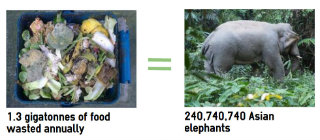
Global food waste happens during agricultural production, postharvest handling, processing, distribution, and consumption. In developing countries, the largest proportion of food waste occurs in the postharvest phase (e.g., storage). Industrialized countries waste the largest proportion of their food during the consumption phase. Consumers in industrialized countries waste about 222 million tons of food annually, which is just over the weight of 201 million Clydesdales.
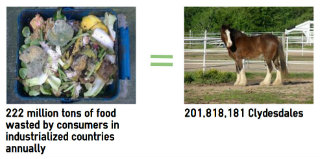
Source — FAO summary report on food wastage footprint
Sustainability's triple bottom line integrates social, environmental, and financial factors (also known as people, planet, and profit) to achieve a balance. Learn more about sustainability's triple bottom line here. Below we look at food waste facts and statistics for each triple bottom line factor.
Wasted food often leads to hunger. The cause of and solution to hunger from food waste differs for developing and industrialized nations.
Forty percent of developing nations' food waste happens in the postharvest phase, which is before food gets to stores1. Thus, less food is available to feed the hungry. Changes to storage structures and practices would decrease food spoilage.
The World Food Programme began the Zero Food Loss Initiative to tackle this problem. Field trials in Uganda cut postharvest food waste from as much as 60% to less than 2%2. The trials also resulted in women and children spending less time in the fields2. Thus, the women had time to make money in other ways and more children attended school.
Industrialized nations' food waste mostly happens at the foodservice and consumer levels1. America recovers only about 10% of edible food to give to the poor and hungry3. One nonprofit organization has developed a plan to reduce food waste in America by 20% within a decade4. The plan expects to double food donations and create 15,000 new jobs4. Ideas include creating food donation tax incentives and standardizing dates on food labels.
Sources
Food waste harms the planet through greenhouse gas emissions, unnecessary water use, and biodiversity loss.
Global food waste accounts for 3.3 gigatonnes of carbon dioxide emissions. If global food waste was its own country, then it would be the third largest emitter after China and the United States. Food waste emits as much carbon dioxide as just over 7 billion passenger vehicles. This figure does not include land use changes to grow crops or raise cattle. Thus, rain forests cut in Brazil for cattle grazing or burned in Indonesia for palm oil are counted separately.
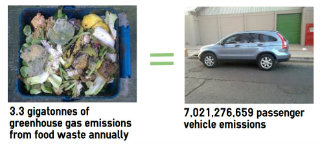
Source — FAO summary report on food wastage footprint
Agriculture is our biggest use of water by far, accounting for 92% of the total. Global food waste loses about 250 km3 of water each year: enough to fill 500 Olympic swimming pools. Cereals account for over half of the water waste, at 52%.
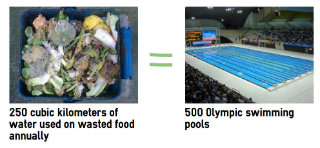
Source — FAO summary report on food wastage footprint
Uneaten food uses almost 1.4 billion hectares of land, about the size of 34 Californias, making up 28% of the world's agricultural land area. Land use for wasted food leads to biodiversity loss for many species. Meat and milk production use the most land, at 78%.
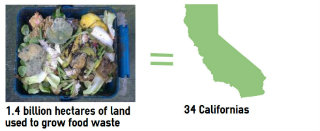
Source — FAO summary report on food wastage footprint
Farmers, manufacturers, stores, restaurants, and consumers all lose money to food waste. Global economic loss to food waste equals $750 billion annually: the same as Switzerland's GDP.
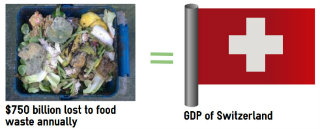
Source — FAO summary report on food wastage footprint
Figures below show economic losses from food waste in America.
Sources